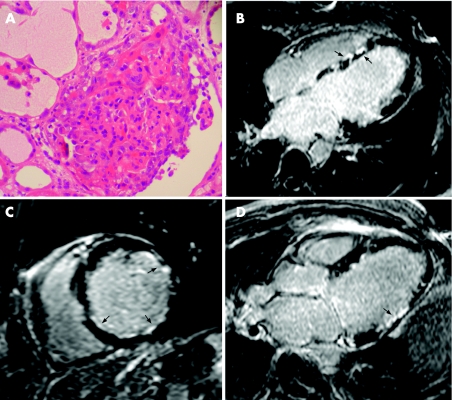A 35‐year‐old man with no history of cardiovascular disease presented with severe biventricular heart failure, after a 6‐week history of fever, rigor, weight loss and unresolving gingivitis. An electrocardiogram showed sinus tachycardia with T‐wave flattening, and chest x ray examination confirmed congestive heart failure and cardiomegaly. Serum troponin I was raised at 20.1 μg/l, and transthoracic echocardiography showed a severely dilated cardiomyopathy with a left ventricular ejection fraction (EF) of 10%. Concurrently, he developed rapidly progressive renal failure (peak creatinine 500 μmol/l) with microscopic haematuria and severe proteinuria. Renal biopsy demonstrated a pauci‐immune glomerulonephritis (panel A). The presence of a positive cANCA confirmed the diagnosis of Wegener's granulomatosis. Dialysis was started, together with cyclophosphamide, corticosteroids and plasmapheresis, resulting in normalisation of renal function and symptomatic improvement of his heart failure. Contrast‐enhanced cardiac MRI (panels B–D), performed 4 months after his initial presentation, showed continuing severe systolic dysfunction (EF = 29%) and multiple foci of delayed enhancement typical of myocardial necrosis and scarring.
The MRI findings are consistent with the sequelae of myocarditis or focal granulomatous necrosis, both of which are associated with Wegener's granulomatosis. The patient remains stable with NYHA class II symptoms and normal renal function.
To view video footage demonstrating severe LV systolic dysfunction and multiple focal wall motion abnormalities, correlating with areas of delayed enhancement, visit the Heart website—http://heart.bmj.com/supplemental
Light microscopy of the renal biopsy, showing typical crescent formation in a collapsed hypercellular glomerulus. Immunofluorescence was negative for immunoglobulins, consistent with a diagnosis of pauci‐immune crescentic glomerulonephritis from Wegener's granulomatosis (panel A). Contrast‐enhanced cardiac MRI—delayed enhancement images: (panel B) four‐chamber view showing foci of mid‐myocardial scarring in the interventricular septum (arrows); (panel C) mid‐ventricular short axis image demonstrating both subendocardial and mid‐myocardial scar (arrows); (panel D) three‐chamber view showing partial thickness subendocardial scarring in the mid‐inferolateral segment (arrows).



